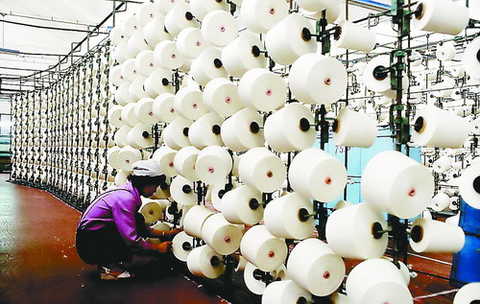According to customs statistics, in January 2017, domestic textile and apparel exports reached 165.68 billion yuan, up 10.2% year-on-year; while in January-December 2016, domestic textile and apparel exports fell 5.9% year-on-year, and domestic textile and apparel exports resumed growth in the first month of 2017. However, combined with positive and negative factors, we expect that domestic and international textile and apparel exports still need to be cautious.

Textile industry
In terms of negative factors, first of all, because of the Spring Festival factor in January, it is usually less comparable.
Secondly, from the past 20 years, domestic textile and apparel exports have declined for the first time in two consecutive years in 2016, and the decline has been expanding year by year. In 2015, domestic textile and apparel exports fell by 4.9% year-on-year. Therefore, it can be judged that domestic textile and apparel exports have entered an adjustment cycle. It is difficult to maintain the trend of rapid growth in the past few years in the future.
Third, in recent years, the cost advantage of domestic textile and apparel exports has been weakening. After 2010, the cost of electricity, labor, land, and environmental costs has been rising.
In terms of positive factors, first of all, the short-term RMB depreciation is good for exports. In January, domestic textile and apparel exports in US dollars increased by only 2.5% year-on-year.
Secondly, the "zero tariff" and "principle of yarn recognition" of TPP pose a potential threat to China's textile industry chain. With the stranding of TPP, it is conducive to the export of domestic textiles and clothing.
Third, the “Belt and Road†countries are gradually becoming a new hot spot for foreign trade. In 2016, China’s exports of textiles and clothing to the “Belt and Road†countries totaled 89.15 billion US dollars, accounting for 33.4% of the total export value. China’s exports to half of the countries Growth has been achieved, and last year it was nearly 6% negative growth, so this is not easy under overall negative growth.
Leading company strong Hengqiang, the competitive advantage is further highlighted
We have recently visited two leading companies in textile trade and two leading textile manufacturing companies with a large export business. From the order point of view, the overall stability before and after the holiday is stable, even with good growth, reflecting the competition of leading companies. The advantages are constantly strengthening. First of all, the leading companies in the textile trade trade have changed their roles in the supply chain integration to enhance their competitiveness, or to integrate resources for the domestic trade business through the advantages of the foreign trade supply chain, to provide supply, or to provide design samples by the company for customers to choose.
Secondly, textile manufacturing leading companies have increased their investment in automation, and the level of automation has been continuously improved. For example, in the spinning section of cotton spinning companies, the previous 10,000 spindle yarns were used by 60-70 people. Now only 40 people are needed. In the worsted section, the previous 10,000 spindle yarns were used for 100-120 people, and now only 100 people.
Thirdly, for textile manufacturing companies, it has always been the focus of national environmental protection supervision because of its large sewage discharge. In recent years, with the strictening of environmental protection policies in various places, the illegal costs of companies that illegally discharge have increased, and industries that invest more in environmental protection. The advantages of leading companies are gradually emerging.
Fourth, the proportion of high value-added products of textile manufacturing leading companies is getting higher and higher. Although the wages of workers in Southeast Asia are one-fourth of that in China, the production efficiency can only reach 60% of the domestic level, and the process of products cannot reach the level. The domestic level, so the current shift of the industry to Southeast Asia can only be a low value-added link. Fifth, leading companies have supply chain systems that are more responsive to the rapid response needs of overseas customers.
Investment Advice
We are optimistic about the rapid increase of industry concentration, the steady growth of performance in recent years, the release of worsted and printing and dyeing capacity in 17 years, the new company (603889.SH), the leading company in the wool textile industry; and the leading companies in other segments, including the world's largest Luthai A (000726.SZ), a manufacturer of high-grade yarn-dyed fabrics, and its steady growth in performance, Lianfa (002394.SZ), the world's second-largest producer of high-grade yarn-dyed fabrics; Huafu, two global oligopoly companies in the color spinning industry Color spinning (002042.SZ) and Blum Oriental (601339.SH); Vosges shares (002083.SZ), the largest towel export company in China.
Polyester Burn Out Flannel Fleece Fabric
SHAOXING WUYUN TEXTILE CO.,LTD , https://www.kexintextile.com